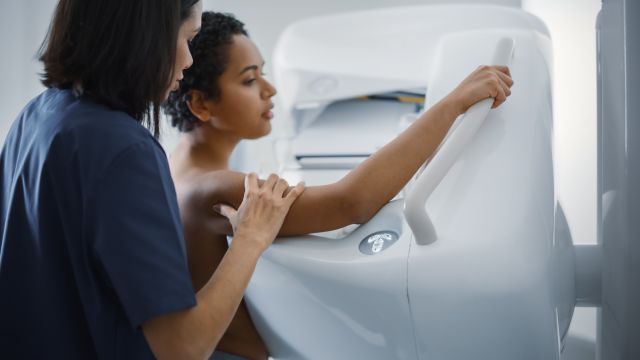Updated on April 30, 2024.
In 2024 alone, the American Cancer Society estimates that 310,720 new cases of breast cancer will be diagnosed in the United States, and 42,250 people will die of the disease. Hands down, mammograms are the best method for early detection, when there are more options for treatment and a better chance of survival. And while experts agree that screening is essential, there’s some disagreement among major medical organizations regarding how often to have it done.
“As with all screening tests, mammography has both benefits and adverse consequences,” says Samantha Bunting, DO, an OBGYN in Plantation, Florida. Each organization weighs these benefits and harms a bit differently, she explains, and that influences their recommendations.
Understanding why the guidelines differ can help you discuss mammography with your healthcare provider (HCP). Together, you can make informed choices about screenings. Here’s what you should know to make the best decision for you.
Getting to know the guidelines
For women with an average breast cancer risk, none of the four major organizations in question advise starting regular mammograms before age 40. The disease isn’t as common during those years, and it’s largely agreed upon that the potential harms (more on those below) significantly offset the benefits. The recommendations are as follows:
- American Cancer Society (ACS): Women can start screening between ages 40 and 45 if they choose. Beginning at 45, the ACS recommends annual mammograms. At 55, getting screened every one or two years is recommended as long as you are healthy and expect to live at least another decade.
- American College of Obstetricians and Gynecologists (ACOG): At age 40, average-risk women should be offered the option. By 50, all women should be screened every one or two years.
- National Comprehensive Cancer Network (NCCN): Yearly mammograms should start at 40.
- United States Preventive Services Task Force (USPSTF): According to a statement issued on April 30, 2024, the USPSTF advises that women begin screening at age 40, with mammograms every other year until age 74. (Previous guidance from the USPSTF recommended that screening start at age 50.)
Keep in mind, mammography recommendations are different for women at a higher risk of breast cancer, such as those with certain genetic mutations or a personal or family history of the disease. These people should typically begin regular screenings earlier and may have them more frequently. Speak with your HCP about assessing your own risk for the disease.
How long should you keep getting mammograms?
In short, there’s no absolute age that screening should be discontinued. Instead, the organizations generally advise that women review their screening decisions when they turn 75 or when life expectancy is 10 years or less. If it’s anticipated that a woman will live another decade, it may be beneficial to keep up with regular imaging.
“It should be a shared decision between the patient and the physician about whether to continue screening or not,” says Dr. Bunting. “This is usually based on a discussion including the information about the risks and benefits, as well as the values of the patient, their concerns, their priorities, and their current health status.”
The basics of benefits and harms
In creating their guidelines for average-risk women, the ACS, ACOG, NCCN, and USPSTF tried to balance the potential benefits of mammograms with their possible harms.
The benefits of mammograms are significant and well-known: Regular screening can prolong and save lives. Between 1989 and 2020, the U.S. breast cancer death rate fell 43 percent, likely due in part to the wider awareness and implementation of mammography.
Mammogram harms may be less familiar to the general public, which is why it’s important to discuss these with your HCP.
One common harm is the potential for a false positive. False positives are mammograms that appear abnormal at first but turn out to be non-cancerous. Whenever someone receives abnormal results from a screening, they are called back for further testing, which can be costly and anxiety-inducing. This happens in about 1 of 10 mammograms.
Other possible harms include overdiagnosis and overtreatment. Overdiagnosis occurs when a mammogram detects a relatively minor cancer—one that would never progress into a life-threatening problem that displays symptoms. Overtreatment is the unnecessary treatment of these cancers, which can cause serious, otherwise avoidable mental and physical side effects.
It’s difficult to tabulate the number of patients who are overdiagnosed and overtreated annually, since HCPs can’t predict exactly which tumors will become potentially life-threatening.
Mammogram radiation may also be considered a harm, but the chance that the X-ray exposure itself could lead to cancer is very low. The benefit of early detection, Bunting says, “far outweighs the risk of dying from any kind of cancer that could be induced from mammography radiation.”
Deciding what’s right for you
As you discuss screenings with your HCP, take these benefits and harms into account. For most people age 40 to 74, the leading organizations feel that that benefits of regular screening tend to outweigh the harms. Your HCP can help you determine the frequency at which you should be screened.
Ultimately, choosing when to initiate regular mammograms is up to each person. Mammography guidelines serve as excellent references, and should be important factors in the decision, along with your individual risk, personal preferences, and the advice of your HCP.
“This is another shared decision-making process with a patient and physician,” says Bunting. Together, you can make the screening choice that serves you best.






